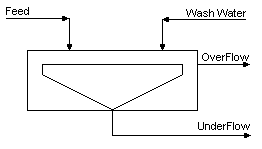Counter Current Decantation (CCD): Difference between revisions
(No difference)
|
Revision as of 04:43, 20 July 2007
Navigation: Main Page -> Models -> Mass Separation Models
General Description
The Counter Current Decantation (CCD) model is used in Mass Balancing mode to quickly determine the concentration in the final over and under flow streams from a series of thickeners. The user is required to specify the number of stages in the system. The underflow from the model will have the same percentage solids as the feed to the system. Any solids in the wash stream will report to the overflow stream.
This model is designed to be used as a quick means of determining the effect of differing numbers of stages or wash water ratio in a CCD circuit. The user may also use a number of Counter Current Washer models in series to model a CCD circuit. By using individual Washer models the user can specify mixing efficiencies, which is not available with this model.
Diagram
The diagram shows the default drawing of the CCD model, with all of the streams that must be connected to the unit. The physical location of the streams connecting to the model is unimportant. The user may connect the streams to any position on the unit.
Inputs and Outputs
|
Label |
Input / Output |
No. of Connections |
Description | |
|
|
|
Min |
Max. |
|
|
Feed |
In |
1 |
10 |
The slurry feed to the CCD |
|
Wash Water |
In |
1 |
10 |
The dilute wash stream |
|
Overflow |
Out |
1 |
1 |
CCD overflow |
|
Underflow |
Out |
1 |
1 |
CCD underflow |
Model Theory
The concentration, Cn, in the final thickener in a CCD circuit containing n stages is calculated using the following formula:
File:Models-Counter-Current-Decantation-Image002.gif
[math]\displaystyle{ \mathbf{\mathrm{C_n=\frac{C-l-C_w}{1+WR+WR^2+.......+WR^n}}} }[/math]
where n - Number of stages in the CCD circuit
- Cn - Concentration in stage n
- Cl - Concentration in the slurry feed to the CCD circuit
- Cw - Concentration in the wash water
- WR - Wash ratio = wash water flow / slurry liquor flow.
Assumptions
- No material is leached from the solids in the process.
- The efficiency of slurry and wash liquor mixing is 100% in all stages.
- The flowrate of solution from each thickener underflow is equal to the incoming slurry flowrate and the wash water flow equals the thickener overflows.
- There is no allowance for evaporation or the addition of any additional streams.
- All solids from the feed will report to the underflow, all solids from the wash will report to the overflow.
- The outlet temperatures are assumed to be the same as the weighted average of all inputting streams.
References
1. P.M.Page, 'A simple equation for CCD calculations' E/MJ Operating Handbook of Mineral Processing, October 1976.
Flowchart
Data Sections
The default CCD access window consists of two sections, the first tab has the same name as the CCD model tag, contains general information relating to the unit. The second tab Audit, fully described in Audit Section. See Model Examples for enthalpy calculation Examples.
First Section - Tag Name
|
Tag / Symbol |
Input / Calc |
Description |
|
| ||
|
Requirements: | ||
|
Stages |
Input |
The required number of stages, or thickeners, in the CCD circuit. The default is three. |
|
Results: | ||
|
WashRatio |
Calc |
The ratio of wash water to the liquid in the feed stream. |
|
UFSolids |
Calc |
Underflow percent solids (Note: all solids from feed stream report here.) |
|
OFSolids |
Calc |
Overflow percent solids (Note: all solids from wash stream report here.) |
|
UFSolConc25 |
Calc |
The underflow solids concentration measured at 25°C. |
|
OFSolConc25 |
Calc |
The overflow solids concentration measured at 25°C. |

